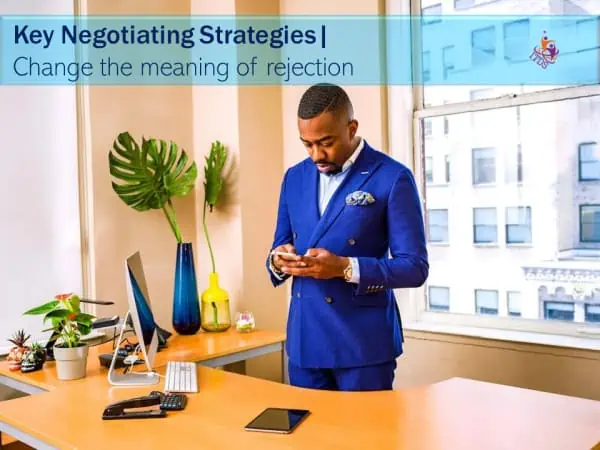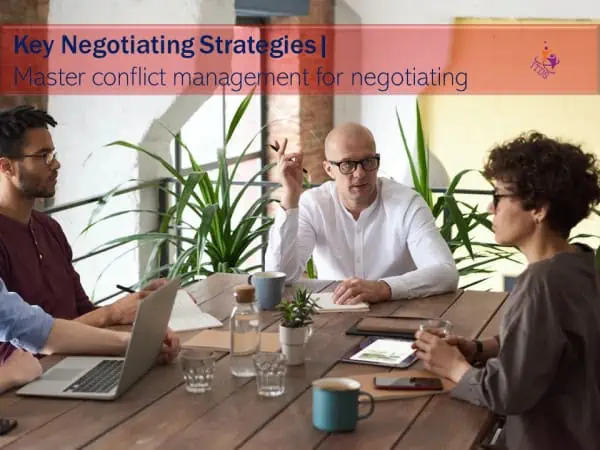Last Updated on April 1, 2024 by Lorna Barrow

If I were to ask you, “What does your business need most?” Without hesitation, you’d say “money!” If you were to ask me the same thing, without hesitation, I’d say “It needs you to have sound negotiating strategies!”
You see, whether you realise it or not, as small business owners (SBOs) you constantly have to be negotiating.
For example, you have to negotiate when:
- you’re working out new buyer/supplier relationships
- you’re dealing with large creditors who don’t see the need to offer you a good deal
- conflict arises around industry/government policies
- new terms are required from your bankers/investors
- you find yourself in conflict with colleagues/adversaries
- most of your staff want holiday at the same time
- your partner wants to go to dinner when you need to work late
So if you can negotiate a successful agreement on any of these, believe me, it’s money in the bank!
Therefore, in this post, I’ll share with you 9 key negotiating strategies which will help you to be successful whenever you negotiate.
So if you’re ready, let’s dive right in. But before we do…
What is negotiating?
Well, first of all, it’s not a contest in which the parties battle for supremacy.
Neither is it a conquest in which you can only win when you crush your opponent.
To me a good definition of negotiating is:
A process by which we address a conflict, disagreement or clash of interests by finding a solution or position that is acceptable to all the parties involved
Inherent in this definition is the fact that when you apply some combination of your negotiating strategies, you should arrive at a successful outcome.
Now for the strategies…
9 Key negotiating strategies for small business owners
- Know what you want from the negotiating process
- Move beyond communicating effectively
- Polish up on (or acquire) debating strategies
- Start negotiating from a position of trust and good faith
- Hold yourself to high standards
- Change the meaning of rejection
- Be at your persuasive best
- Master conflict management for negotiating
- Become familiar with the 3-D approach to negotiation
1. Know what you want from the negotiating process
Knowing what you want is usually important. But when you’re negotiating, it’s vital.
Think about it…if you don’t know what you want, how will you know when you get it?
Unfortunately, many people negotiate just because they think they should.
Sounds crazy, doesn’t it?
I once had the misfortune to sit on a procurement committee for an important organization.
I was told that the Chair was a skillful negotiator and given my previous Trade Union background, I was anxious to see him operate.
But pretty soon, I realized that he arbitrarily negotiated every proposal that came before him.
When I asked him what he wanted from these negotiations, he smugly replied, “Oh! I negotiate everything!”
Really?!
When you’re clear about what you want, you are in a much better position to recognise it when it presents itself.
Remember the super negotiator I mentioned above?
Well, on 2 occasions, I watch how he started negotiating for what was already in a proposal. All that was really needed was for him to ask a few strategic questions.
2. Move beyond communicating effectively

Communicating effectively is a general requirement for your business (and life) success.
But in negotiating, you need to move beyond that to “controlling the conversation’.
As negotiating strategies go, controlling the conversation helps you to get to “YES” in the shortest possible time.
You see, whoever controls the conversation controls the outcome. And in the process, you will also command the respect of others.
A word of caution though: Controlling the conversation implies that you already know how to communicate effectively. If you’re not sure, brush up on your communication before you attempt to control any conversation.
Now here are 3 quick tips to help you control any conversation:
1. Ask (sensible) questions
Whoever is asking the questions is in control of the conversation. This is true even when some other person has power by virtue of their position. Ask for clarification, ask to repeat key points or even for facts to be explained in a better way so you can understand.
2. Listen attentively
Remember that everyone has an ego. Therefore, make a point of giving each person your complete attention when they are talking. That person will feel valued and significant and more open to your point of view when you share it. The better you become at listening, the more easily you will command power in a conversation.
3. In a conversation, “give” first
“Giving” could mean giving information or advice or offering to help fix a problem. This creates the situation where everyone is more open to listening to you and you get the chance to say what you need to say. When you do, you will realize the power you have to influence with just words and an attentive audience.
3. Polish up on (or acquire) your debating strategies
The term “debate” has many meanings. But when I talk about it as it relates to negotiating, I’m talking about how you discuss the pros and cons of an issue, a proposal or a proposition.
In my experience as a trained public speaker, I find a good negotiating strategy is to be able to apply some of the fundamentals of a formal debate when you’re actually at the table.
When you can, you will be better able to convince your opponent that your position is the more desirable one.
Here are some tips to help you:
- Identify the key or winning issue you must address
- Be sure of your position on that issue
- Collect and analyse as much information as you can on the issue
- Prepare your opposition’s side of the “debate” and use that to prepare yours
- Analyse your audience carefully
- Prepare your speech or presentation to persuade your audience that your position is the best one
- Have at least 3 pieces of “evidence” to support your argument
- Use public speaking skills to present your argument confidently and calmly
- Dress appropriately and appear professional
The above tips work whether you’re negotiating with 1 or 100 persons.
4. Start negotiating from a position of trust and good faith

Far too often, people start negotiating from the position that the other party is an enemy who cannot be trusted.
But here’s the problem with that…
When you employ this approach as a one of your negotiating strategies, it leads you to be extra cautious.
So you engage in deals with few tradeoffs. You hardly give any concessions and you share very little information with the other party.
As to be expected, the other party senses that you’re not being trustworthy and mirrors your behaviour.
Then the negotiations either reach a stalemate or become long and protracted.
So, what can you do to engender trust in negotiations?
You can start by leading by example. Begin by believing that the other party is competent, has character and is trustworthy. Then demonstrate that this is how you feel.
But trust in business shouldn’t start at the negotiation stage.
You can learn to leverage it when you build and conduct your business on principles and values which are customer-focused.
5. Hold yourself to high standards
As negotiating strategies go, having high standards is non-negotiable.
To me having high standards is a psychological thing that separates the good from the great in an uncompromising way.
Your high standards are usually driven by the values you set for you and your business. In other words, your values set.
When you have high standards, you’re confident and it shows even as you enter the negotiating venue.
You also know your “deal breaker” and your opponent instinctively knows that the negotiating encounter will be of a high calibre.
When you hold yourself to high standards you will come to the negotiations properly prepared, having paid attention to even small details.
On the other hand, your standards do not give you the right to be judgmental or overbearing enough, to be anything less than pleasant and decent during the negotiating process.
Also, there’s something important you must know about having high standards. For them to work as a negotiating strategy, they first has to be a way of life for you!
6. Change the meaning of rejection

I get it. No one likes to feel rejected. Not even top salespeople.
But people will reject you no matter how well you dress, how successful you are or even how kind you are.
I am sure by now as a small business owner, to get where you are, you’ve endured your (un)fair share of rejection. Or even ridicule.
But in negotiations, knowing how to deal with rejection must be one of your super negotiating strategies.
Listen, I once told my girlfriend that when I want something badly enough, when people say “NO!” I hear “NOT NOW!” Surprisingly, she called me sick.
Dealing with rejection as you negotiate requires a similar strategy.
So what if you can interpret “rejection” as “feedback?”
Doing so is a mindset shift that immediately forces you to answer the question: “How must I change my approach to get what I want?”
In answering that question, two things happen.
First, you immediately shift into thinking of strategies and approaches to get what you want.
Second, you short-circuit any resentment you might have felt when your efforts were rejected.
Now when you set out to negotiate anything, anticipate rejection. Think of it as feedback and plan to level-up your negotiating strategies to deal with it, early in the process.
7. Be at your persuasive best
How many times have I sat in negotiations and watch the parties make such poor attempts at persuading each other?
Too many.
To be at your persuasive best in negotiations, you need to understand 2 things. These are (1) the elements or pillars of persuasion and (2) how to deliver a persuasive speech.
Let me briefly break them down for you.
(1) There are 3 elements or pillars of persuasion:
1. Logic – This is the facts, figures, statistics and other forms of documentation which you use to support your case. Make sure these are from credible sources and that you share these sources.
2. Emotion – You can’t rely on logic alone to be persuasive, however sound your logic is. Any good salesperson will tell you that people buy with emotion and justify the purchase with logic. It’s the same with negotiating. Grab them by the emotion and convince them with the facts.
3. Credibility – the basic components of credibility are competence, honesty and trustworthiness. You need to exploit these, especially when you’re presenting your case.
(2) How to deliver a persuasive speech
As a Small Business Owner, when you are delivering a top-level persuasive speech, you’re actually performing your ceremonial leadership role of “influencer.”
To me, influence is how you move people from resistance to compliance to commitment. This is exactly what you want to do when you’re negotiating.
To achieve this, you will have to:
- Know how to own your audience
- Anticipate how your audience will respond
- Present your case professionally
- Have basic public speaking skills
- Craft a meaningful call to action (CTA)
You can learn how to get these right in the post “how to deliver a persuasive speech.”
8. Master conflict management for negotiating

Ideally, here is what you want when you’re negotiating:
“The ability to present an unpopular position that creates little or no hostility and preserves the other person’s sense of dignity.”
The problem is, too many negotiations take place in an atmosphere of animosity. That’s because there is a tendency to polarize every problem as two opposing viewpoints, offering no middle ground.
In other words, the conflict is personality-based.
As part of the process in managing conflict in negotiations, you have to ensure that the parties focus on the issues and not the personalities.
Here are some strategies to help you focus on the issues:
- Be clear on what you see as the issues and share these upfront
- Exhibit self-confidence and open-mindedness in your approaches
- Take responsibility for your communication and its consequences
- Use objective, verifiable information to support your points
- Keep your word and follow through on your commitments
- Collaborate sincerely to achieve mutually beneficial outcomes
- Be willing to address unpleasant or uncomfortable situations
- Develop your ability to separate negative emotions from the real issues
- Know how to deal with difficult people
9. Become familiar with the 3-D negotiating strategy
Up until now, I’ve focused mostly on strategies that are best used as “at the table” tactics.
Now, I have to tell you that relying on tactics alone, every time you negotiate, is not your most effective negotiating approach.
Depending on the nature of the negotiation, a better approach is when tactics are a part of a 3-Dimensional approach which also include deal design and set-up.
As a matter of fact, whole books have been written about 3-D negotiating.
Let’s take a brief look at the 3 dimensions together.
1. Tactics – the first dimension happens at the table and focus on people and processes. Sound tactics or strategies are necessary when you meet your opponent face-to-face. I’ve given you several of those in 1 – 8 above.
2. Deal Design – the second dimension, happens away from the table. This is where you make sure you establish details of the deal. In the first instance and in good faith negotiations, the deal should bring value to both sides. However, if that original deal fails, you can draw up a better deal, right at the table.
3. The Set-up – the 3rd dimension, happens away from the table. This is where you work to ensure that:
-
-
- you’re negotiating with the right party
- you’ve clearly defined the issues
- you also understand the underlying issues
- you can even influence the seating arrangement at the meeting
-
When you can leverage the 3 dimensions in the right combination, your chances of succeeding in any negotiation are greatly increased.
Your next “negotiating strategies” steps
Now that you have 9 great negotiating strategies, your next steps are easy.
- Go through the strategies and identify the ones you’re weakest at.
- Choose one and begin your “homework” improvement as soon as you can
- The next time you have a “simple” negotiation, apply the relevant one
- However, if you have a complex negotiation, get expert help and be willing to pay for it!
To your negotiating success…



